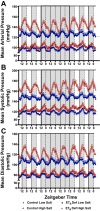Diurnal pattern in skin Na+ and water content is associated with salt-sensitive hypertension in ETB receptor-deficient rats
- PMID: 29351432
- PMCID: PMC5966816
- DOI: 10.1152/ajpregu.00312.2017
Diurnal pattern in skin Na+ and water content is associated with salt-sensitive hypertension in ETB receptor-deficient rats
Abstract
Impairment in the ability of the skin to properly store Na+ nonosmotically (without water) has recently been hypothesized as contributing to salt-sensitive hypertension. Our laboratory has shown that endothelial production of endothelin-1 (ET-1) is crucial to skin Na+ handling. Furthermore, it is well established that loss of endothelin type B receptor (ETB) receptor function impairs Na+ excretion by the kidney. Thus we hypothesized that rats lacking functional ETB receptors (ETB-def) will have a reduced capacity of the skin to store Na+ during chronic high-salt (HS) intake. We observed that ETB-def rats exhibited salt-sensitive hypertension with an approximate doubling in the diurnal amplitude of mean arterial pressure compared with genetic control rats on a HS diet. Two weeks of HS diet significantly increased skin Na+ content relative to water; however, there was no significant difference between control and ETB-def rats. Interestingly, HS intake led to a 19% increase in skin Na+ and 16% increase in water content (relative to dry wt.) during the active phase (zeitgeber time 16) versus inactive phase (zeitgeber time 4, P < 0.05) in ETB-def rats. There was no significant circadian variation in total skin Na+ or water content of control rats fed normal or HS. These data indicate that ETB receptors have little influence on the ability to store Na+ nonosmotically in the skin during long-term HS intake but, rather, appear to regulate diurnal rhythms in skin Na+ content and circadian blood pressure rhythms associated with a HS diet.
Keywords: circadian rhythm; endothelin; salt; skin; sodium.
Figures




Comment in
-
Clocking skin sodium.Am J Physiol Regul Integr Comp Physiol. 2018 Apr 1;314(4):R542-R543. doi: 10.1152/ajpregu.00453.2017. Epub 2018 Jan 3. Am J Physiol Regul Integr Comp Physiol. 2018. PMID: 29351424 Free PMC article. No abstract available.
References
-
- Birukov A, Rakova N, Lerchl K, Engberink RH, Johannes B, Wabel P, Moissl U, Rauh M, Luft FC, Titze J. Ultra-long-term human salt balance studies reveal interrelations between sodium, potassium, and chloride intake and excretion. Am J Clin Nutr 104: 49–57, 2016. doi:10.3945/ajcn.116.132951. - DOI - PMC - PubMed
-
- Dhaun N, Moorhouse R, MacIntyre IM, Melville V, Oosthuyzen W, Kimmitt RA, Brown KE, Kennedy ED, Goddard J, Webb DJ. Diurnal variation in blood pressure and arterial stiffness in chronic kidney disease: the role of endothelin-1. Hypertension 64: 296–304, 2014. doi:10.1161/HYPERTENSIONAHA.114.03533. - DOI - PubMed
Publication types
MeSH terms
Substances
Grants and funding
LinkOut - more resources
Full Text Sources
Other Literature Sources
Medical

